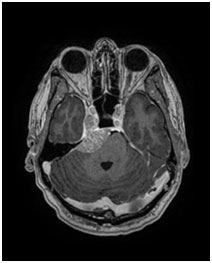What is a meningioma?
Meningiomas are benign slow growing tumours that arise from the lining of the brain called the Dura. Some of them can be more rapidly growing or malignant.
What causes meningiomas?
At this point in time we have no known cause. However, certain previous radiation to the head, increases the risk of formation of these tumours. They are also more common in women and so may respond to female hormones.
Where do meningiomas occur?
They can arise anywhere within the skull and spine. As they arise from the membrane that contains the brain and spine, they are on the surface and press on the brain or spine. Rarely they can arise within the ventricles (fluid cavities)

How do meningiomas affect your health? What symptoms do they cause?
Meningiomas is the brain can cause the symptoms listed below (but not exclusively)
- Seizures (fits)
- Headaches
- Loss of use of your arm or leg
- Inability to speak
- Decreased vision, double vision
- Confusion
- Double vision
- Hearing loss
- Dizziness
Sometimes meningiomas can be found incidentally on scans performed for other reasons.
Spinal meningiomas can cause:
- Pain in spine or leg or arm
- Weakness, numbness of leg arm
- Loss of function of legs
- Loss of bladder or bowel control
What happens after I am diagnosed with a meningioma?
Please see patient journey after diagnosis of a brain tumour
What is the current recommended treatment for meningiomas?
Treatment for meningiomas depends on various factors:
- Size
- Location
- Symptoms
- Age and general condition of patient
Management options are
- Watch and wait
- Surgery alone
- Surgery and radiation
- Radiation alone
How is surgery done for meningiomas?
Surgery to remove meningiomas generally involves a craniotomy.
The position of the craniotomy depends on where the tumour is. Computer based navigation is used to guide surgery.
Occasionally, certain skull base meningiomas can be removed endoscopically via the nose.
The degree of resection of tumours is quantified using the Simpson grade (I-V). A Simpson grade I resection refers to a completely removed tumour while a grade V resection is a simple biopsy. The resection grade achieved depends very much on the location of the tumour.
If there has been an incomplete resection, the residual may either be watched closely with regular MRIs or treated with radiation.
Please see the section on surgical techniques for more details.
How quickly do these tumours grow?
Meningiomas are graded by the WHO (World Health Organisation) to give us a guide as to how quickly they grow.
Grade I – 90% of meningiomas. These are very slow growing and on average grow 1-2mm per year.
Grade II – 8%. Also called atypical meningiomas. More rapidly growing and greater tendency to recur after surgery.
Grade III – 2%. Also called malignant meningioma. Rapidly growing and invades brain and can also spread throughout the brain and elsewhere.
What other treatments are available?
Some small meningiomas can be treated with focused radiotherapy.
Other larger tumours may require a combination of surgery radiation.

















